Hi, and welcome to all for 2013. I hope the whirlwind known as 2012 deposited everyone on the doorstep of this new year in good shape. Mildly frazzled perhaps, but whole of mind, body and spirit, ready to start turning the blank pages of these new twelve months, with all the unknowns and things hoped for. I remain blessed, I feel, in that I start another year with a camera in hand. Three days of shooting this week. Four next. So it goes. It will not always be thus, so I treasure the moments behind the lens with increasing fervor. I joke about the passing of time and frames with my buddy Bill down at the National Geographic. Another year for him living inside the land of the yellow border, indeed, a place where the wild things roam. Me, being a freelance content provider, I’m just the occasional interloper, trouble maker and, dare I say, problem solver. Though it’s completely open to fair questioning as to whether I’ve created more problems than I’ve solved. Best not to dwell on such matters.
Best, really, just to keep moving. 2013 beckons like a siren, and yawns like a chasm to be crossed, all at once. Inviting, drenched in possibility, but fearsome all the same. Once again, clench your teeth (among other things) and slide out onto the tightrope known as freelancing. Maybe, someday, I’ll try my hand at something more certain, like my dad, who actually had a job, and whose briefcase, like some sort of shield, bears the scuffs and marks of doing business. Or Annie’s dad, who was a telephone company lineman, and a foreman, and a volunteer firefighter. Joe McNally and Tommy Cahill. A pair of Irishmen who almost certainly would have liked each other, and shared more than a few boilermakers, but died too young, and improbably, ended up buried within fifty yards of one another. The respective totems of their estimable lives hang side by side in the hall of our house.
Maybe someday I’ll give up this nutty freelance thing, but I kinda doubt it. Being comfortable with not knowing what you’re doing next week or next month for the last 35 years makes one unprepared for the trappings of certainty and routine of schedule. I’ll keep you posted.
I recently threw a new picture up onto Facebook, and a couple folks sent me some lighting queries about it. So, as a first entry for 2013, here goes.
I knew I wanted to photograph Raul Samarillo Sanchez from the first moment we were introduced. A formidably talented sculptor, he had given me a gift of his work. How to repay? Go to his workplace and make a picture. I inquired about his time. He said to come on over.
You get a sense of people, really. I knew his studio would be as interesting as he is.
Three basic things, rules, perhaps, or, more accurately, admonitions, run through my head when I venture to a place like this.
1) Try not to fuck this up.
2) Shutter speed is my friend.
3) Make the flash look like it’s supposed to be there.
And, as always, work fast. The place had a couple big windows, but light was fading fast, and rolling away from that side of the building. I had to favor the natural direction of the light, but augment it with flash. First thing to do was to figure composition. Rule of thirds, tried and true, worked in this instance. I put Raul on camera left, and then started to orchestrate the wonderfully charismatic mess of the sculptor’s workplace. (Also, to be understood–I would still be there, making pictures, if I could. There’s an array of visual potential in this place. I chose one slice, and worked on it for a while. I would love to be there in the morning, and watch him work, throughout the day. Hopefully, next time.)
The fading sunlight created a nice splash in the far corner of the studio, but alas, that was about to leave for the day, so I replaced it with Quadra unit, ramped up to full power at 400ws, and fitted with a warming gel. This was angled so that it reached to the back and right of the studio, and provided a little raw illumination, roughly akin to hard, late sun. It picked up the details of the place, the finished and half finished work, as well as the tools, dust, and just general stuff one accumulates during a talented life.
This was fairly early on in the proceedings, shot at 16mm, which is a pretty wide view. I needed to get tighter, sharper, and, as you can see, I was having problems with the right hand of the Lord. I needed to push my subject left in the frame, but the far edges of that particular zoom for me was a no fly zone. I ended up shooting the D800 fitted with a 24-120 zoom, and of course stayed at the wide end of that optic. Below is a lighting diagram of sorts. As you can see, behind Raul is a large shelf, or loft, which means the wall back there was in total darkness. A Justin Clamp, an SB-9oo running on SU-4 (manual slave operation) with a full CTO gel filled this in a touch, and its presence is made logical by the work lamp that already exists back there. Up front, I used a tri-flash with three SB 900 units (though, truth be told, as I remember now, it was a mix of 900 and 910’s) firing through a Lastolite Skylite Panel, the 3×6. I swear by this panel, honestly. It’s a beautiful diffuser, configured in the shape of a window, so when you place it in front of virtually any light source, it looks like (doh!) a soft window light. Sometimes, it takes a while for me to figure this stuff out.
The game plan for a location like this, for me, is a well traveled road. Observe the existing quality of light–even the scraps of it can inform where to put the flashes. Then, forget about the light for a bit and find the picture. Get the frame. If the frame works, and has power and logic, so will your lighting. Then, make the light look like it’s appropriate to the scene. Raul is an old world, traditional sculptor, so it’s advisable to leave the ring light in the trunk, and go for softer, artisanal quality of light to match the scene and the craftsmanship at hand. Find the right combo of shutter speed and f-stop. The shutter speed is like adjusting a Levolor blind. You crack it open just wide enough to admit enough ambient light into the room so that your flash doesn’t look overly flashed. In other words, you “bleed” daylight into the scene, but not too much, or you lose the control your flash gives you over the scene. The game of ratios–what exists, and what you layer over what exists–continues. Also, try to make use of what’s there. The work lamp on JC is helpful. The finals on the finals were D800, 1/20th at f8. The sizable f-stop here is important. You want to see the details. They tell the story of his life.
And, once you have it lit, don’t give up on it too soon. Find something else, like, his hands.
And of course, try not to, well, you know…..more tk….
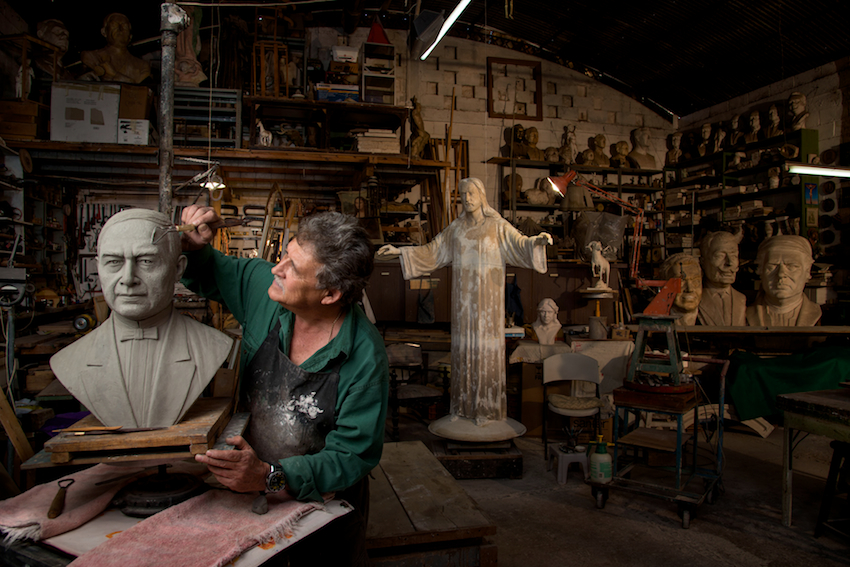
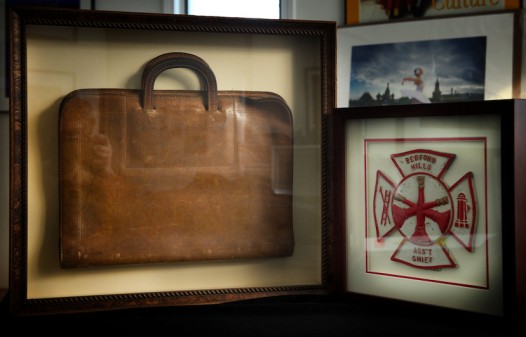
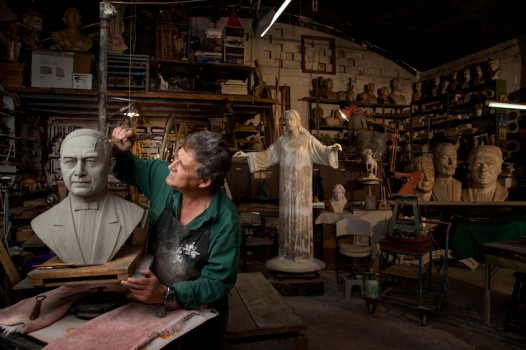
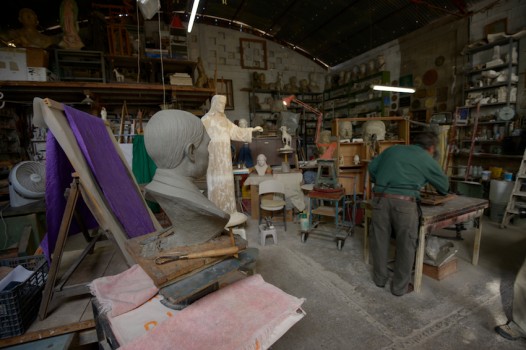
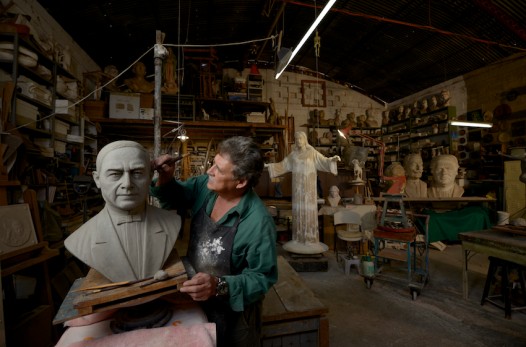
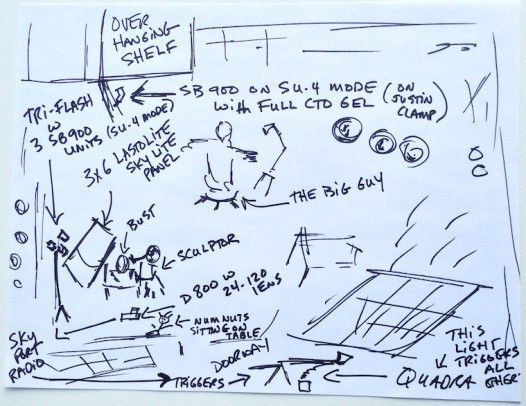
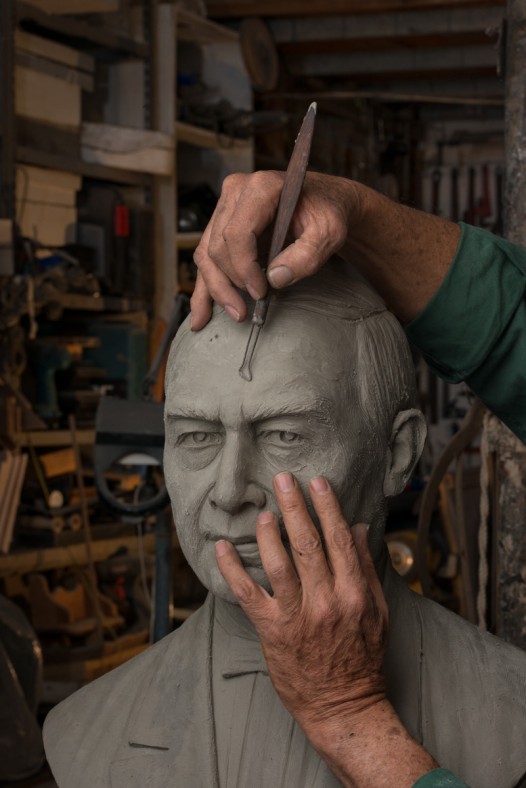
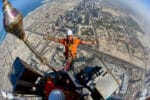
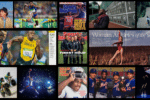
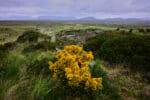
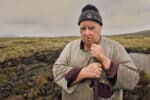
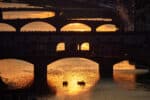
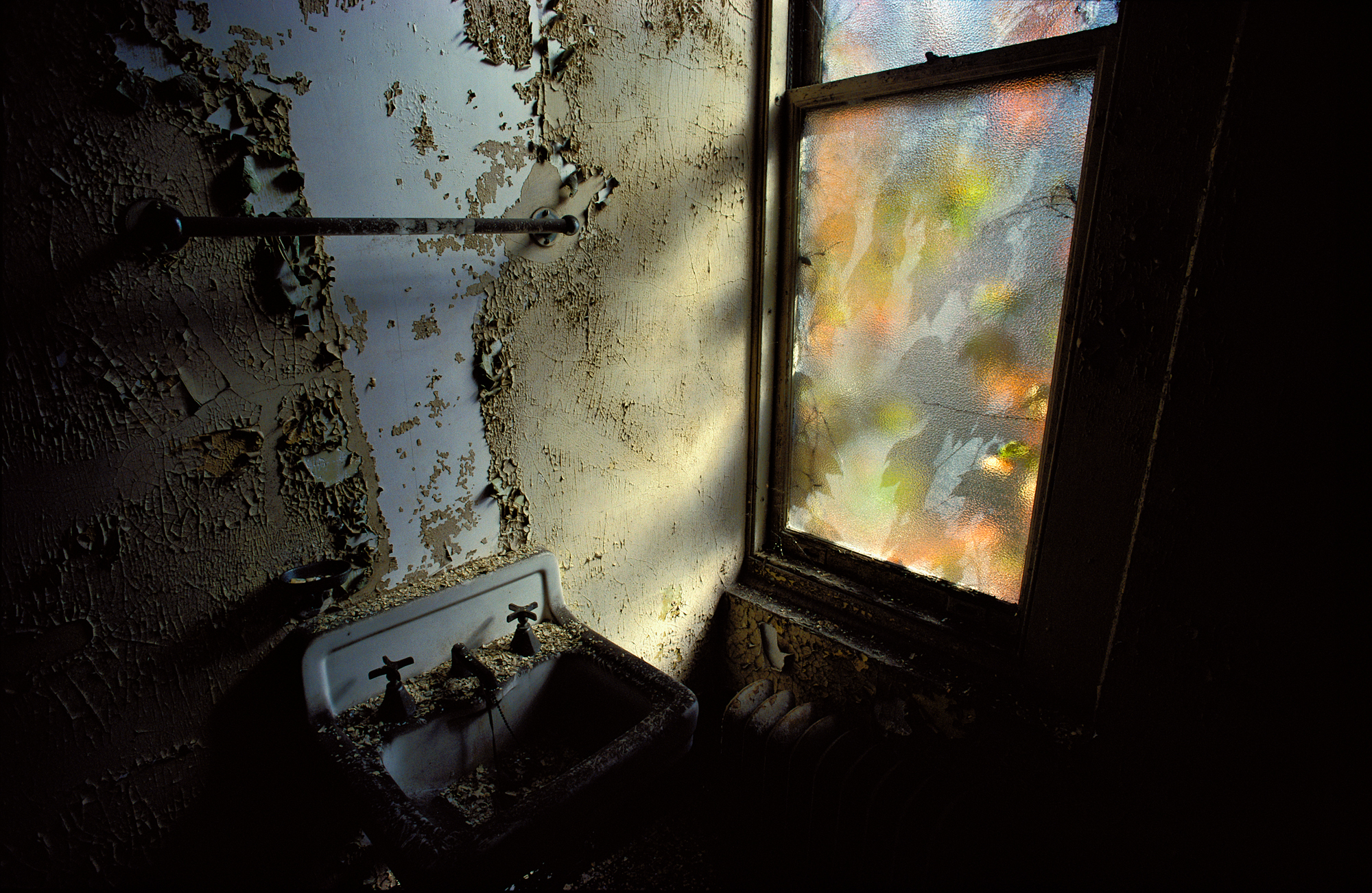
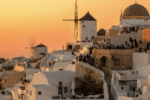

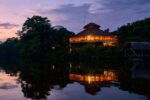
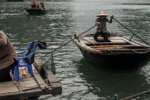
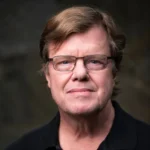


Another masterfully done piece, Joe. Thank you again and again for sharing your knowledge with all of us. Your writings, books, seminars and musings have done so much to bring my knowledge of lighting along hugely in the last few years. Best for 2013!
Geart!!
Thanks again Joe for the way you continue to lift us up with your instruction and insight. You are a world class sculptor of light.
Hi;
I really like the light, I am sure you get that a lot. What got me to ask this questions is your comment; “Then, make the light look like it’s appropriate to the scene. Raul is an old world, traditional sculptor, so it’s advisable to leave the ring light in the trunk, and go for softer, artisanal quality of light to match the scene and the craftsmanship at hand.” This is the type of lighting I like and want to grow. If I could only purchase one of your books, or DVD (do you have dvd’s?), Which one would it be, knowing this is the type of light I want to build on? Thank you in advance, Dennis.
Happy new year, Joe! Nice reading as always, keep up the good, nutty work 😉
Thanks for that story and the lighting diagram. I needed about 2 minutes to work it out but as soon as I did, the whole image made sense. Not that the image was confusing in the first place, but I’m one of those guys that first enjoys a beautiful image and after that I try to figure out the lighting. I’s a bit easier with a lighting diagram, but I have to admit, the first minute I just stared at the drawing and I didn’t know, where to start. After that I remembered the saying of Zack Arias “You have to start somewhere” and that’s what I did.
Looking forward to your next blog post.
Ciao Björn
Great story, thanks!
never stopped enjoying a blog post from you, Joe…. always learning from you!
Happy 2013 Joe, there’s more to learn from just the one paragraph under the diagram then most complete books have to offer. I consider you my teacher, as well as a great photographer/ writer… now, if you could just tell me how to develop that eye.
Russ Gelardi
Joe your innate talent to spin such an entertaining yarn with each photo is a rare gift. You paint with words and it always leaves me envious.
Wow.. incredible first entry for 2013.. Thanks Joe.. Wish you an incredible 2013 from Chile!
Thanks for the lighting diagram. I can always pick up a trick or two from you.
PeteSuttonFineArt.com
Wonderful! I received Z. Arias ‘One Light’ dvds last month and have been studying with my little flash. New to off camera flash, I am pleased that I understood most of what was presented here! Thank you, Joe, for always caring enough to share.
Cheers!
Joe, Aside from the fact that I always find you, well, entertaining, I can’t tell you how helpful this stuff is to me. You are a master at what you do with a real gift for teaching. Thank you, thank you, thank you, for not hoarding your knowledge!
Feliz Año Nuevo!
Great no-nonsense article Joe. My question is related to you establishing the light/power ratios between the strobes. Do you guess (swag or kinda know just because you can smell the scene) then try, review, try again or how do you meter?
Joe,
Great job as always. Looks like ceiling mounted fluorescents in the background. You mention the back SB-900 under the shelf had a CTO gel but didn’t say about the ones on the tri-flash. So I’m counting 4 different color temps including the ambient. How did you sort this all out, since I don’t see any blue green from the fluorescents?
Refering to Jesus in the diagram as “The Big Guy” ? Too cool.
Loved the article.
Thank you Joe …for all you share.
Wow, that was a great explanation of what you did in Raul´s shop ! Thanks for that !
Honored to assist you that day !
Best, Héctor Segovia
PhotoXperience México 2012
with Joe McNally
Congrats on the previous year. Glad you can still find time to get behind the camera too. So often so we lose sight of what brought us here in the first place.
Thanks Joe. More knowledge to lock away. Great images!!
Great start to the New Year! Thank you, Joe, for sharing so much information. I just loved decoding the abstract expressionistic diagram. The links to gear climb to the top of my 2013 Adorama shopping list. I can’t thank you enough.
Hi Joe,
Happy 2013! It’s always a pleasure stopping by your blog and learning a thing or two. I’m a fellow seeker of LIGHT and I too push around a few Speedlights. I once used 45 Canon Speedlights in three groups to light a WWII airplane at night shot from a helicopter, good times. Our paths have crossed on several occasions, we have a mutual friend Dan Okrent from Time Magazine. I did a stint freelancing for Time many years ago, but have since moved onto to the wonderful world of weddings. Weddings really push me to use all of my lighting tricks and photographic skills in one given day!
The next time we are at the same convention / trade show I’ll pop for a cup of coffee. Will you be at Imaging or WPPI?
Anyways keep on keeping on…. Like my former chief photographer Bob Kotalik at the Chicago Sun-Times used to say, “shoot a holder for me….”
Cheers,
Bob Davis
Good stuff, Joe!
What a great post for the start the year! I definitely need to put rules 1 and 3 in practice!
My best wishes for you guys!
Good to hear from you Bob…won’t be at WPPI though…our paths will cross sometime or other…all the best for the new year. Joe
Hey Louis…yep, surprised me a touch as well this file looked as clean as it did. I’m in sunny white balance, straight up. Influenced my background warm with gels, as you indicate. Up front, no gels for the main light. There was enough daylight bleeding into the frame to clean things up, and where you really see warmth is where it would have been dark, so that makes sense. And the fluorescent lights just get drowned here. There just ambient accents…best, Joe
Hi Stephen…metering is matrix for the whole scene, and I just find a good f-stop and then dial shutter, dial shutter till I’m happy that the ambient levels are just there, and then I can influence the mix with flash. Kind of a gut call, I guess…best, Joe
Joe,
What are your thoughts on the 24-120 lens? Specifically, how does it stand up compared to the 24-70 and how is it with flare? It’s not on your “what’s in the bag” list.
Thanks,
ms
Hi…don’t have that much experience with it. That one was a borrowed lens. I do have one as a knockabout lens, and I have friends who swear by them, Bill Frakes, noted sports photojournalist among them. It’s a great handy lens, but for critical portraiture, I would come down on the side of the 24-70. It’s super sharp and fast. Joe
This post is very timely for me, Joe. It saved me some searching today for tips on lighting a musician and his recording studio in a few days. I won’t light it exactly the same but this inspires me and gets me started.
Thanks as always.
Lyle
Joe, the very best of wishes to you all all those dear to you for a fabulous 2013! So … I thought I was going to enjoy a cup of coffee and an entertaining read in your blog before I got on with some retouching this morning. Then you wrote about a setting on the SB-910 which I do not know how to make happen. Into the owner’s manual for me! (Your blog, books, DVDs, and The Adorama Flashbus Tour finally converted me from another brand–I bought my first full-frame Nikon and a lone SB-910 six weeks ago.) But … not sure whether to thank you for adding to my knowledge or to say “S***! He sure screwed up my entertaining read.”) So, where to next week???
Wow. thanks for for taking the time to decode all this for us all. as the kids say these days: ‘you’re sick!'(like a rockstar!)
Wow Joe, what a beautiful image, thanks for sharing, and giving us so much information. Your blog is a wonderful place to pop by once in a while.
Thanks
Darragh
Your an inspiration Joe. Just a beautiful perfectly lit portrait of a craftsman…by a craftsman. Good luck for 2013 from us over here on the emerald isle. Can’t wait to see what you come up with this year…..hope your bringing out more books!
Slan Abhaile
Happy New Year Joe..
As always the words guide me and the image motivates me to pick up my camera every day and try. Question… I understand the choice of fstop and shutter but, what ISO are you at? I find often I am at ISO 800 on my D800 when attempt. I want ISO 200 but never seems enough..
Thank you for inspiring me to be a better photographer every day.
Tooth
Thanks so much for your lighting diagrams – they’re both an inspiration and a humbling experience. I find I’m often stumped by workspaces, not wanting to interfere too much and often taking far more time to come up with lighting than I would like.
Keep posting ’em,
Mathias
Joe, on reading and re-reading, one thing I do not get here is what is triggering the Quadra unit. The other is “why SU-4 mode?” The photo is positively engaging, a treat for the eys! Thank you for blogging on this particular image.
I would love to pour over the detail in this on a large print.
Hi Don…the main select I showed was ISO 100 on the D800…..all the best for 2013..Joe
Hi Stu….the Quadra, even though it was outside, and lighting the back of the room, was the “main” light in certain ways in that it triggered the all the other lights. The Quadra would pop, via the radio, and the speed lights, set in manual slave mode, or SU-4 in Nikon speak, would then react to that pop by triggering. I was lucky the sensor panels on the SB units are pretty sensitive. Had no problems with them not firing, thankfully. All the best, Joe
Great blog post Joe. Love the way you can light a subject with out it looking over lit or lit at all. Very natural.
Did you have to go to confession before spending so much time with the big guy?
Your the MASTER!!! Great ideas. Thanks
Joe, THANK YOU for your answer. You wrote “thankfully.” Somehow, I don’t think it was mere good fortune. Anyway, it’s a great shot and, through the blog, you gave us a wonderful lesson in shooting. All the best, always …
Happy New Year Joe. Great setup..
Just wanted to say Thank You for a great 2012 in photography terms. You’ve educated me, made me laugh and inspired me.
Oh and I like those little hand drawn ‘more’ buttons you have on your blog!
Wishing you your best year yet for 2013.
Linda xx
Hi Joe, a really nice piece about how you look to creat an image. I love your line above that says “Make the flash look like it’s supposed to be there”
A beautiful image that inspires me to create more with my flash set up.
Thanks
Nick
Hi Joe,
I just love the amount of attention you are paying when comes down to lighting and composting. Your work is so inspiring. It must be such a pleasure to work with such interesting people and to make them look in their best.
Yes Joe the master 😉
All the best
Nikolay.